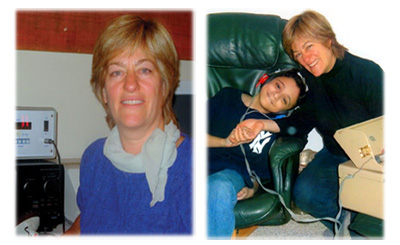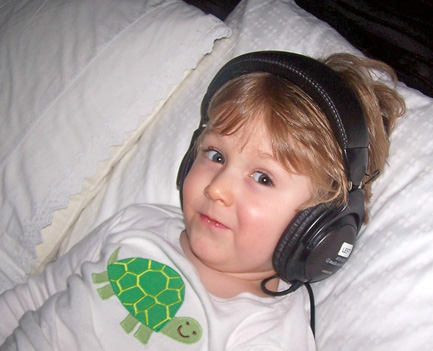HOW TO CHOOSE THE BEST PROVIDER...
There are so many doctors and other providers out there. How do I know who is best for my child or me?
When it comes to choosing a provider for something as important and personal as medical treatments, psychotherapy, Auditory Integration Training or other therapeutic and educational services for you or your child, it is helpful to have an idea of what to look for and what questions to ask.

How to choose the best Provider for you:
Training and Education - Choosing a provider with training from an accredited School, training or certification program gives the security that they have met at least a certain minimum standard of education and training in your field of interest.
Specialty and General Experience - It is important for a provider to have wide experience, be well rounded in their practice, in addition to being knowledgeable in their specialty. This provides them with the tools to recognize symptoms and factors which may lie outside their usual realm of specialty and allow for referral to other providers, when appropriate.
A Systems Approach - A Systems approach is a more holistic way of looking at the person not only as an individual with individual strengths, weaknesses or neurotic issues, but also understanding that each person is a part of different systems such as family, work, school, community, etc. This gives the provider both “telephoto” and “wide-angle” lenses through which they may see many different avenues of treatment.
Years of experience - the width and depth of knowledge and skill acquired through many years of experience in the field is unparalleled by a provider fresh out of school. There is both an art and a science to implementing AIT and other therapies of all kinds. Understanding how to individualize the program to suit a person’s needs means not only doing a good “textbook“ evaluation of the issues, but also being experienced in the clinical issues that may occur through the course of treatment and being able to offer guidance and suggestions as the person goes through the program. Sometimes, there can be reactions with which a client or parent is not sure how to cope. The practitioner can draw on experience to evaluate which are appropriate reactions and provide suitable, supportive interventions when needed.
Understanding individual and family dynamics - Sometimes after AIT there will be a change in interpersonal dynamics. When a child is finally able to count on more accurate and clear sensory information, they may become more independent and assertive of needs and wants. This may be disturbing and take some understanding and adjustments for parents and family members who are accustomed to being relied upon and are now needing to relate in different ways. Years of provider experience can help to anticipate, assess and ease this process.
Understanding Appropriateness of Differing Modalities of Treatment - Interventions and supervision begin with treatment and continue for long afterward. A good practitioner will be able and available to assist and guide parents in choosing and prioritizing follow-up treatments; for example, knowing when other specific therapies might be helpful and how to best coordinate them. Many treatment modalities are available today. A good practitioner will help you navigate them, not just end their involvement once treatment has finished.
Personality - Being able to relate and get along well with your provider can make all the difference. Do you feel heard and cared for? Do you feel that they are taking the time needed to make good evaluations and treatment recommendations? Do you feel comfortable to be able to bring up difficult or delicate issues? A good provider will make you feel comfortable and heard.
Treatment opens the doorway.
Good follow-up, education and parenting help keep it open.
Sarah Gewanter, MSW, LCSW is a highly skilled Licensed Clinical Social Worker, Hypnotherapist and Certified Berard Auditory Integration Training Practitioner and Educator. She attended Columbia University in NY and has over thirty years experience in the field, having helped thousands of clients worldwide.
LETTER FROM A PARENT...
Our son was diagnosed with mild to moderate autism in the summer of 2008 at the age of 2 ½. He would rarely look at us and had stopped speaking. Over the course of the next year and a half we tried all kinds of things such as: removing all dairy, gluten, soy, and rice from his diet (he also has a disease called eosinophilic esophagitis or “EE” and this also made this radical diet necessary), vitamin and mineral supplements, B 12 shots, and 40 treatments in a hyperbaric chamber (which did seem to help his EE). We also enrolled him in special education classes and began speech therapy sessions in our home. What changes we saw in him came about very slowly. We were terrified that at this rate he may never speak or interact with us in a meaningful way. At home, conversations between two people were enough to send him into his closet to hide. In the classroom, he was unable to pay attention at all and regressed quite a bit until the teachers moved him to a quiet classroom and would often take him out for one on one session as this was the only way he was able to concentrate. I knew noises were an issue but did not have any idea what we could do about it. Sound is a part of our world.

I don’t remember where we got the information regarding Berard AIT. I think my husband came across it on the Internet. We were skeptical but began our first session over Christmas break 2009 into the New Year. We didn't’t see how this was going to help but we gave it a shot. We did not tell his teachers we had done the AIT and when he went back to school after the break the reports were astonishing. They would come to the car everyday when we picked him up and tell us about all the progress he was making. He was talking! He was pointing and labeling things in an entirely new way. He needed very little, if any, prompting and seemed to enjoy this new verbal world. The difference between before and after the treatments seemed to be the miracle we were looking for.
Now, my husband reminded me that we don’t live in a vacuum and that we couldn’t be entirely sure that the AIT therapy was the reason for all the dramatic changes we were seeing in our son, but it sure seemed like it.
We decided to go through a booster treatment of 4 sessions a few months later. Two weeks after the booster treatments I began toilet training my son again. I had been working on this with him off and on for a year. He was finally able to understand the concept and I am happy to report he is completely toilet trained!
We are about to begin another 20 sessions during this summer vacation. I am looking forward to this as the last 2 times we completed a series we have seen a jump in his progress. Although my son cannot yet express what he is experiencing during these sessions, the results, in my opinion, speak for themselves.
We are still working with him each and every day to keep him engaged and encouraging him to speak and participate in the world around him. Our son is still autistic and is not yet conversational but he has changed so much in the last 6 months that we are simply amazed. AIT has taken our family out of darkness and given us much needed hope. Thank you!
Heather F. –June 30, 2010
If you have a friend who you think may benefit from this information we will be happy to send him or her a
copy of this newsletter.
Just email: info@aithelps.com or mail us the name and address to:
AIT
690 Boyd Rd.
Leicester, NC 28748.

